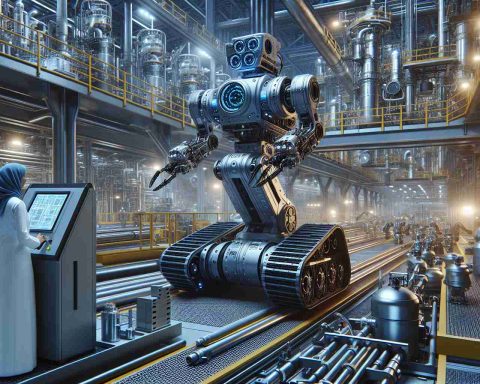The Future of Robotic Companions Takes a Shocking Turn
In a world where technology rapidly evolves, the recent demise of a beloved robot companion, Moxie, serves as a jolting reminder of the fragility of modern innovations. Created by Embodied, Inc. in 2020, Moxie was designed to be a special friend for children with autism. Priced at $799, it quickly found its way into the hearts of many families seeking support for their kids.
Regrettably, the Pasadena-based company has filed for bankruptcy, leaving Moxie’s future in doubt. As a result, this once-promising robot will soon become an expensive ornament that cannot fulfill its intended role. Parents now face the delicate task of explaining this situation to their children, a conversation that could prove excruciatingly difficult.
Imagining a child who has formed an emotional bond with Moxie now facing its abrupt silence is indeed a troubling thought. They might wonder why their animated companion has vanished overnight. The complexities of explaining financial struggles and technological dependencies to young minds is no easy feat, leading to inevitable disappointment.
As Moxie fades into obsolescence, families are left grappling with a poignant reality. While advances in robotics have the potential to make significant impacts, the unpredictable nature of the industry reminds us that these advancements may sometimes come at a heartbreaking cost. Thus, amidst the excitement of technology, there lies a bittersweet layer of vulnerability.
Reviving Robotic Friendship: Alternatives and Innovations in Companion Robots
The Future of Robotic Companions
The recent bankruptcy of Embodied, Inc., the creator of the Moxie robot, has left many families in distress over the future of robotic companions. Launched in 2020 as a supportive friend for children with autism, Moxie’s $799 price tag made it a notable entry in the landscape of therapeutic technology. However, its abrupt end prompts a deeper examination of the evolving world of companion robots, the innovations shaping their future, and the emotional implications for families reliant on them.
Innovations in Robotic Companions
Despite Moxie’s challenges, the field of robotic companions is witnessing remarkable innovations. Newer designs focus on emotional intelligence, enhanced interaction, and adaptability. For example, companies like Intuition Robotics are developing robots that make meaningful connections through conversational AI and contextual awareness. These advances promise not only to support children but also to engage with seniors and individuals with disabilities, broadening the scope of companionship robots.
Pros and Cons of Robotic Companions
Pros:
– Support for Emotional Well-being: Robots can provide companionship and emotional support, particularly important for children on the autism spectrum.
– Educational Benefits: Many robots enhance learning through interactive experiences, encouraging cognitive growth and social skills.
– 24/7 Availability: Unlike human companions, robots are available at all times, catering to various needs whenever they arise.
Cons:
– High Costs: Many robotic companions come with steep price tags, which can be a barrier for some families.
– Dependence on Technology: The reliance on these devices raises concerns about emotional attachment versus human interaction.
– Longevity and Reliability Issues: As seen with Moxie, the future of technology and the companies behind it can be uncertain, leading to abrupt discontinuation of support.
Comparisons with Other Companion Technologies
When comparing the options available, Moxie is part of a niche market. Companionship robots like Sony’s Aibo and more recent developments from companies like Anki provide varied functionalities but may lack specific therapeutic focuses. For instance, they are generally geared toward entertainment rather than targeted therapy and development for children with autism.
Use Cases of Robotic Companions
Robotic companions are being utilized in various settings, including:
– Therapeutic Environments: Several healthcare facilities now integrate robotic companions to aid in therapy sessions, promoting relaxation and interaction.
– Education: Schools are beginning to incorporate robots for teaching social skills and collaboration among children with different needs.
– Elderly Care: Companion robots are being used in nursing homes to help combat loneliness among residents, providing interaction and companionship.
Limitations and Challenges
While the potential of robotic companions is vast, there are notable limitations:
– Emotional Understanding: Many existing models still struggle with genuine emotional recognition and response, leading to potential misunderstandings.
– Cost of Maintenance: Beyond the initial purchase, upkeep, and potential software updates can add to the overall cost of ownership significantly.
– Privacy Concerns: The integration of AI in homes raises questions about data privacy and surveillance, necessitating robust security measures.
Market Analysis and Future Predictions
The market for robotic companions is projected to grow significantly. According to recent studies, the increasing focus on mental health and technology’s role in therapy will propel further innovations. Analysts predict that by 2030, companion robots will not only be commonplace in households but will also integrate seamlessly with smart home technology, enhancing their functionalities.
Conclusion
While the closure of Embodied, Inc. and the uncertainty surrounding Moxie is a stark reminder of the vulnerabilities in high-tech ventures, the future of robotic companions continues to hold promise. As the field evolves, new technologies are on the horizon, and with them come the potential to redefine how we perceive companionship in an increasingly digital world.
For more insights on the latest in robotic technology, visit TechCrunch.








